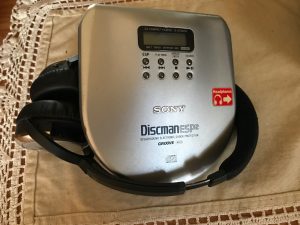 What kind of a librarian reads only sparingly and reluctantly? The kind who has to be mindful about screen time and number of pages read. The kind who routinely adds Alt Text and image descriptions on websites. The kind who occasionally turns on closed captions during Zoom presentations to ensure the audience can follow. The kind who is dedicated to support the inclusion of blind, low-vision, and low-tech users, because it hits them close to home.
What kind of a librarian reads only sparingly and reluctantly? The kind who has to be mindful about screen time and number of pages read. The kind who routinely adds Alt Text and image descriptions on websites. The kind who occasionally turns on closed captions during Zoom presentations to ensure the audience can follow. The kind who is dedicated to support the inclusion of blind, low-vision, and low-tech users, because it hits them close to home.
The kind who embraces audiobooks, because listening to books for fun spares the eyes precious hours without overtaxing them.
The fascinating history of the audiobook actually goes back to an initiative aiming at inclusion. It was the American Foundation for the Blind that first established a recording studio in 1932 to record books on vinyl. Each side held about 15 minutes of speech. The next year Congress passed an amendment that allowed the Library of Congress to begin producing audiobooks. The first attempts included a chapter from Helen Keller’s Midstream and Edgar Allan Poe’s The Raven, followed by full titles by Shakespeare, Kipling, and Wodehouse.
Currently, according to their web site, the National Library Service (NLS) is a free braille and talking book library service for people with temporary or permanent low vision, blindness, or a physical, perceptual, or reading disability that prevents them from using regular print materials. The New Jersey Talking Book & Braille Center is our regional branch.
 A parallel story illustrating inclusion began with Anne T MacDonald, assistant director of the Nurses’ Aide Corps of the American Red Cross during WWII. As a member of the Women’s Auxiliary at the New York Public Library, she learned about the need for audiobooks for veterans of the war, who suffered vision loss. She founded The National Committee for Recording for the Blind in New York City in 1948, and established recording studios in other cities, too. The main goal was to help these soldiers continue their education with the help of textbooks recorded on vinyl phonograph disks. Shifting focus on students with learning differences, such as dyslexia, the organization, currently called Learning Ally, expanded into helping them and now helps nearly a half million students with learning differences.
A parallel story illustrating inclusion began with Anne T MacDonald, assistant director of the Nurses’ Aide Corps of the American Red Cross during WWII. As a member of the Women’s Auxiliary at the New York Public Library, she learned about the need for audiobooks for veterans of the war, who suffered vision loss. She founded The National Committee for Recording for the Blind in New York City in 1948, and established recording studios in other cities, too. The main goal was to help these soldiers continue their education with the help of textbooks recorded on vinyl phonograph disks. Shifting focus on students with learning differences, such as dyslexia, the organization, currently called Learning Ally, expanded into helping them and now helps nearly a half million students with learning differences.
Commercial companies soon followed suit, transitioning from vinyl to tape to cassettes to mp3, ending up in streaming audio and providing us with a wide range of audiobooks to purchase or borrow from the local public library.
Next time you post an image or use crazy-funky fonts heavy on the eyes, please remember those whose source of receiving the information is limited or reduced. Thank you, on behalf of them all. And the next time you feel like sparing your eyes, consider picking up an audiobook.
More on the history of audiobooks
- Alison Thoet (2017, November 22). A short history of the audiobook, 20 years after the first portable digital audio device
- Rubery, M. (2011). Audiobooks, literature, and sound studies. Routledge.
- Moyer, J. (2012). Audiobooks and e-books: a literature review. (Report). Reference & User Services Quarterly, 51(4), 340–354.